Rabbit farming is an increasingly popular and profitable agricultural venture. The success of a rabbit farm largely depends on the farmers' ability to provide a conducive environment for their furry inhabitants. One crucial aspect of rabbit husbandry is temperature control. Rabbits are highly sensitive animals, and their well-being, health, and productivity are greatly influenced by the surrounding temperature.
In this comprehensive blog, we will delve into the importance of understanding the ideal temperature range for rabbits in barns, the physiological impact of temperature on rabbits, and effective temperature management strategies to ensure optimal rabbit welfare and productivity.
The Physiology of Rabbits and Temperature Sensitivity
Before exploring the ideal temperature range, it is essential to grasp the physiology of rabbits and their sensitivity to temperature. Unlike many other animals, rabbits are unable to sweat, which limits their ability to regulate body temperature effectively.
As a result, they are more susceptible to temperature extremes, especially in hot or cold environments. Their small size and high metabolic rate also contribute to their sensitivity. Understanding these factors emphasizes the need for careful temperature control in rabbit barns.
Factors Influencing Ideal Temperature
The ideal temperature range for rabbits in barns is influenced by various factors, including age, breed, activity level, and weather conditions. Young rabbits, for example, are more sensitive to temperature changes than adults. Certain rabbit breeds may also have different temperature preferences.
Moreover, rabbits that are more active may tolerate slightly lower temperatures than those that are less active. Farmers must take all these factors into account while determining the optimal temperature range.
Defining the Ideal Temperature Range
The ideal temperature range for rabbits in barns typically falls between 10°C to 20°C (50°F to 68°F). Within this range, rabbits experience minimal stress and perform optimally in terms of feed intake, growth, and reproduction. The upper limit of the range helps prevent heat stress, while the lower limit ensures protection from cold stress. Maintaining a consistent temperature within this range is vital for maintaining rabbit health and productivity.
The Impact of Temperature Extremes on Rabbit Health
Temperature extremes, whether hot or cold, can have significant adverse effects on rabbits' health. In hot weather, rabbits may suffer from heat stress, leading to reduced feed intake, lethargy, and an increased risk of dehydration and heatstroke.
On the other hand, cold temperatures can cause cold stress, leading to huddling, reduced movement, and increased susceptibility to respiratory illnesses. Long-term exposure to extreme temperatures can weaken the rabbits' immune systems, making them more prone to diseases. To avoid such health issues, farmers must prioritize maintaining the ideal temperature range in their barns.
Temperature and Reproductive Success
Temperature plays a critical role in rabbit reproduction. Maintaining the ideal temperature range is crucial for successful breeding and reproductive performance. Extreme temperatures can disrupt the breeding cycle, leading to lower conception rates and increased stillbirths. Consistent temperature monitoring and control significantly improve reproductive success, resulting in healthier litters and increased farm profitability.
Heat Management Strategies for Rabbit Barns
During hot weather, effective heat management strategies are essential to keep the barn's temperature within the ideal range. This section will explore various heat management techniques, such as proper ventilation, shade provision, misting systems, and cooling pads. Implementing these strategies ensures that rabbits remain comfortable and stress-free, even during scorching weather.
Cold Management Strategies for Rabbit Barns
In cold weather, rabbits require adequate protection from low temperatures. This section will discuss various cold management strategies, including proper insulation, draft prevention, and the use of heating systems. By creating a cozy and warm environment, farmers can safeguard their rabbits from cold stress and maintain their well-being and productivity during winter months.
Monitoring and Controlling Temperature
To maintain the ideal temperature range, it is crucial for farmers to adopt advanced temperature monitoring and control systems. This section will explore the use of modern temperature monitoring devices and automated systems that allow farmers to track and adjust temperatures efficiently. Remote monitoring solutions enable real-time data analysis, providing farmers with instant alerts in case of temperature fluctuations, even when they are off-site.
Training and Educating Farm Staff
Effective temperature management requires the active involvement of farm staff. Training and educating employees about the significance of maintaining the ideal temperature range and the appropriate application of temperature control strategies are vital for successful implementation.
Conclusion
In conclusion, understanding the ideal temperature range for rabbits in barns is a fundamental aspect of successful rabbit farming. The physiological sensitivity of rabbits to temperature fluctuations necessitates careful temperature monitoring and control.
By maintaining the ideal temperature range, farmers can enhance rabbit welfare, reproductive success, and overall productivity. Implementing appropriate heat and cold management strategies, along with modern temperature monitoring systems, ensures that rabbits thrive in their barn environment.
By prioritizing temperature control, farmers can create a healthy and sustainable rabbit farming operation, leading to increased profitability and a rewarding farming experience.








